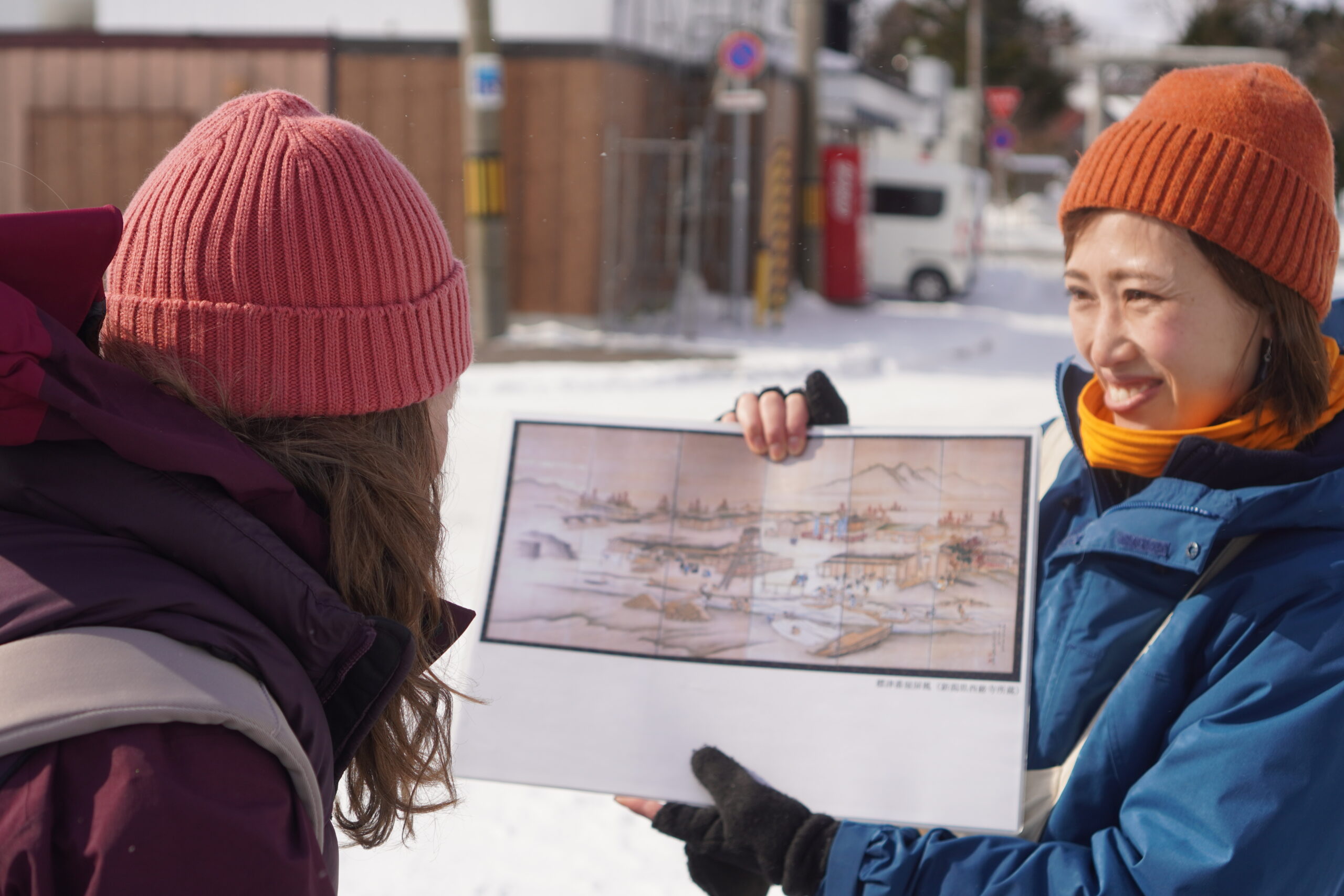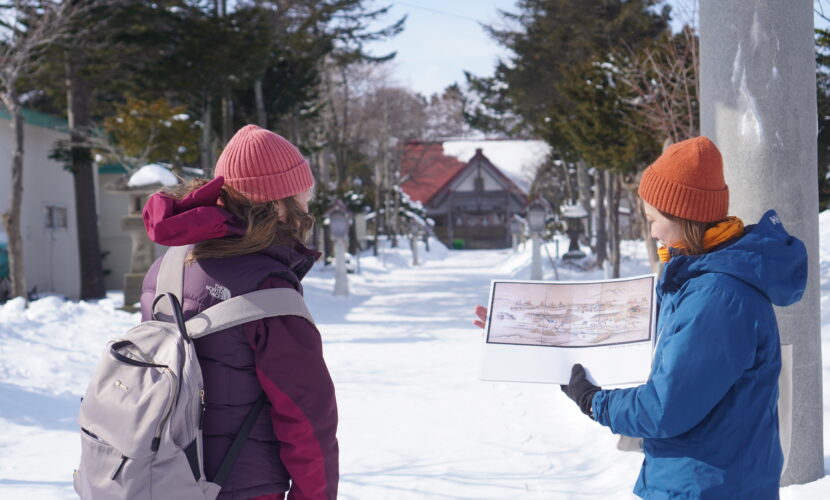取材:TRAVEL HOKKAIDO ピタ大畑
北海道の東端にある小さな漁業と農業の町、標津は、町を訪れる人々に豊かな地元体験を提供することを誇りに思っているコミュニティです。 標津での日常生活は、何百年もの間、何千年にもわたって地元に存在してきた伝統を受け継いでおり、この豊かな歴史と文化を探索することは、この地域を旅する素晴らしい追加要素です。 標津町の名前はアイヌ語に由来しており、意味を調べてみると、「大きな川」を意味する説と、「サケの多い場所」を意味する説がありました。 標津を初めて訪れたとき、どちらが適しているかはすぐにわかります。
標津での冒険を始める朝、標津ガイド協会所属のガイド、齋藤智美さんに会いました。彼女は、旅行者の経験を地元の生活に織り込むツアーを提供するガイド サービスを提供しています。 齋藤さんは温かく熱心なガイドで、母国語の日本語に加えて英語も話します。 彼女は、地元の漁師との出会いから、ホタテの試食、根室海峡サーモン茶漬けの作り方と試食、ご飯にスープベースを注ぐことまで、印象的な文化と食べ物の紹介を提供しています。そして、標津番屋屏風をモチーフにした街歩きツアーも実施しています。
この郷土の作品は、会津藩の絵師が1864年に描いたと思われる標津番屋の絵を屏風に飾ったものです。 町の枠組みが今も非常に追跡可能な形で存在していること。 目の前のプリントに描かれている通りを文字通り歩くと、信じられないほどの体験ができます。 齋藤さんは、このルートの重要なポイントに立ち寄り、現在は近代的な銀行が建っているサケを保存するために使用された建物の場所など、歴史的に興味深い場所を指摘します。 標津神社もこの屏風と同じ場所に堂々と残っており、町めぐりの重要な立ち寄り場所となっています。
標津の街を歩いていると、斎藤さんが過去の物語と現在の物語を融合させる素晴らしい能力を持っていることに気づきます。 地元のサケ産業の歴史や根室海峡周辺への影響などを織り交ぜながら、町を紹介してくれます。 彼女は頻繁に立ち止まって、この歴史を現在のビジネスやコミュニティの主要人物に関連付けます。 彼女と一緒に町を探索すると、サーモンやその他のシーフード、地元のスイーツを専門とする地元の店を訪れる機会があります。 標津はその歴史の上に成り立っており、その歴史はサケに非常に焦点を当てていることがわかります。 町を探索するたびに、サーモンがこの場所のアイデンティティーにとっていかに重要であるかを実感します。
標津番屋屏風は、幕末の会津藩が、この地に大量に産出する鮭を資源として利用し、地域を発展させていた様子を描いたものです。 この絵は秋の日を描いており、複雑なディテールが町の歴史、建物、人々を示しています。 大きな川には小さな漁船が行き交い、近くでは北海道の先住民であるアイヌの人々が働いているのを見ることができます(アイヌの人々自身がこの時代に搾取されていたことを忘れてはなりません)。 サーモンはボートに積み込まれ、貯蔵小屋に運ばれ、後で加工するために魚を乾燥させるために塩漬けにされます。 江戸時代の発展は、今日のこの地域で見られる商業的な鮭産業につながる歴史的に重要であり、この屏風に描かれた絵は、どのようにして地元の鮭が日本を代表するブランドの 1 つになったかについての洞察を与えてくれます。 (明治11年(1878年)、西別川河口に別海缶詰工場を設立)
齋藤さんのツアーは、地元の漁業を間近で見られる標津港へと続きます。 漁業は常にこの町の中心であり、この地域での高い雇用は依然として貿易に直接起因しています。 秋に鮭が標津に戻ってくると仕事が増え、鮭の旬の時期に町は活気づきます。 地元では、サケはこの再会を象徴しています。生まれた川に戻って産卵し、次の世代のサケが生まれて人生の旅を終えるときです。 この地域でサケを漁ったり食べたりする歴史は数千年前の縄文時代にさかのぼり、このサイクルが数千年にわたってさまざまな形でこのコミュニティに影響を与え続けてきたと考えると信じられないほどです。
ようやくたどり着いたのは、根室地方最古といわれる標津神社で、晴れた冬の日は静かで風光明媚な場所です。 町の中心部にありながら、印刷物に描かれているように、神社の敷地は静かで、熟考する場所です。 齋藤さんは、5月になると境内を埋め尽くす桜並木を教えてくれ、春の訪れが待ち遠しくなります。 神社自体は、1781年から89年にかけて幕府の漁場請負業者によって、海上安全と豊漁を祈願して建てられたと言われています。 建物は改築され、経年変化を遂げていますが、神社境内に入って鮭の形をした祈願札を見ると、神社の歴史や内容も鮭が中心であることを今でも感じることができます。
齋藤さんのおかげで、この町の歴史が今につながっていることを実感しています。 ガイドは単に知識を与えるだけではなく、歴史や文化に触れる体験を通じて人と地域をつなぐ役割を担っていることを彼女は知っています。 標津での短い滞在を通して、過去の豊かさと現在の活気を感じながら、楽しみ、食事、学びの 1 日を過ごすことができたと感じています。



